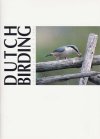Dutch Birding volume 24 (2002) no 2

Claw length and origin of Pine Grosbeak at Melissant in March 1996
On 24 March 1996, an adult male Pine Grosbeak Pinicola enucleator was photographed at Melissant, Zuid-Holland, the Netherlands (de Zoete & Meininger 1998). One of the photographs was also published in van den Berg & Bosman (1999, 2001). This record was rejected by the Dutch rarities committee (CDNA) because the claws were considered too long for a wild bird (Wiegant et al 1998). Schaftenaar (1999) questioned this decision with reference to the frequent loss of red plumage coloration in captive seed-eating birds (which was not the case in the Melissant bird) but, after reconsideration by the CDNA, the bird was still regarded as an escape (see editorial comment in Schaftenaar 1999).
In December 2000, we (Rob Bouwman and Justin Jansen) observed several Pine Grosbeaks at Nymölla, Skåne, Sweden, together with several other birders. These birds were part of a large invasion into southern Fenno-Scandinavia in late autumn and early winter of 2000. We noticed that a first-year male that could be studied at close range had long claws. Remembering the discussion provoked by the Melissant bird from 1996, we asked Pierre Unge and Martin Helin to put a message on the Swedish and Finnish birdnets, respectively, for more information on this subject. As a result, we received several reactions, including photographs of Pine Grosbeaks with long claws. Probably the most striking photograph was sent by Jouni Riihimäki who informed us that he was (also) considering a note for Dutch Birding discussing the origin of the Melissant bird. This photograph and the photographs taken by RB at Nymölla show that there are birds - of undisputed wild origin - with even longer claws than the Melissant bird. Another example is presented by a photograph of an adult male taken by Jari Peltomäki at Oulu, Finland, in January 2000 (see Alula 7 (1), 2001, back cover). We also received a reaction from Jörgen Palmgren of the Zoological Museum of the University of Helsinki, Finland. He measured several Pine Grosbeaks and noted a variation in claw length between 7.9 and 11.3 mm. In 12 birds, the mean length of the middle claw was 9.4 mm and of the back claw 8.5 mm. The variation in claw length can be considerable, even between the toes of one foot. An adult male found dead at Tampere, Finland, in February 1984 had, on one foot, a claw of 6.9 mm on the left toe and of 11.3 mm on the middle toe.
As indicated in de Zoete & Meininger (1998), the claw length of the Melissant bird was estimated to be twice as long as normal. There was, however, no indication of what was used as a reference for a 'normal' claw length in Pine Grosbeak and there was no reference to sample size. Because the Melissant bird was not caught, the estimated claw length could only be based on photographs and the statement that it was 'twice as long as normal' is thus poorly substantiated. Therefore, we think the Melissant record refers to a Pine Grosbeak with a claw length within the normal variation; the claw length alone would then be insufficient reason to reject this record as a presumed escape.
Justin J F J Jansen, Blitterswijckseweg 3, 5871 CD Broekhuizenvorst, Netherlands
justin.jansen de-aa.nl
de-aa.nl
Rob G Bouwman, Herdersveld 52, 5665 JS Geldrop, Netherlands
robbouwman hetnet.nl
hetnet.nl
The information collected by Rob Bouwman and Justin Jansen was sent to the CDNA in early 2001 and, as a result, the record was reconsidered based on this new information. The CDNA decided that there was sufficient reason to accept the record as referring to a presumed wild bird. Since the claw length was the main reason to reject the bird previously and since there were no (strong) indications of captive origin in plumage (coloration and/or wear), bill shape, behaviour, date of occurrence and locality, the bird received the benefit of the doubt and has now been accepted as the fourth Pine Grosbeak for the Netherlands; previous records were in December 1909 (2) and November 1928, all three at Rotterdam, Zuid-Holland (van den Berg & Bosman 2001). The fact that the largest invasion of Pine Grosbeaks in Denmark since 1954 occurred in November 1995, a few months prior to the Melissant record (cf van den Berg & Bosman 2001), adds credibility to a presumed wild origin of the Dutch bird (but is considered no more than 'circumstancial evidence') (Jan van der Laan in litt). EDITORS
terug






